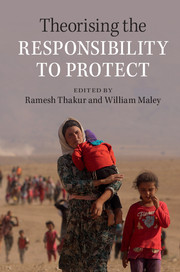Book contents
- Frontmatter
- Contents
- List of figures
- Notes on contributors
- Part I Context
- 1 Introduction: theorising global responsibilities
- 2 The evolution of the Responsibility to Protect: from concept and principle to actionable norm
- 3 From the right to persecute to the Responsibility to Protect: Feuerbachian inversions of rights and responsibilities in state–citizen relations
- 4 The Responsibility to Protect and a theory of norm circulation
- Part II The Responsibility to Protect, normative theory and global governance
- Part III The Responsibility to Protect and international social purposes
- Index
1 - Introduction: theorising global responsibilities
from Part I - Context
Published online by Cambridge University Press: 05 August 2015
- Frontmatter
- Contents
- List of figures
- Notes on contributors
- Part I Context
- 1 Introduction: theorising global responsibilities
- 2 The evolution of the Responsibility to Protect: from concept and principle to actionable norm
- 3 From the right to persecute to the Responsibility to Protect: Feuerbachian inversions of rights and responsibilities in state–citizen relations
- 4 The Responsibility to Protect and a theory of norm circulation
- Part II The Responsibility to Protect, normative theory and global governance
- Part III The Responsibility to Protect and international social purposes
- Index
Summary
One of the most important developments in world politics in the last decade has been the spread of the twin ideas that state sovereignty comes with responsibilities – both domestic and international – as well as privileges, and that there exists a global responsibility to protect people threatened by mass atrocity crimes. The 2001 report of the International Commission on Intervention and State Sovereignty entitled The Responsibility to Protect put these ideas into active circulation, and United Nations resolutions in 2005 on the sixtieth anniversary of the establishment of the United Nations gave the idea further substance. More recently, the justification of NATO action in Libya on the strength of Security Council Resolutions 1970 and 1973, which made explicit reference to the principle of the Responsibility to Protect, has put this particular notion at the centre of discussion of some of the most challenging political dilemmas of our times. As international leaders struggle to find ways to deal with mounting political violence in Syria and more recently with the emergence of the self-styled ‘Islamic State in Iraq and Syria’, the idea of the Responsibility to Protect, now increasingly labelled simply R2P, is never far below the surface.
These concrete political developments have helped to generate a substantial scholarly literature concerned with the genesis of the idea of the Responsibility to Protect, and with the way in which it has been refined through multilateral deliberation. Through mainstream as well as dedicated journals such as Global Responsibility to Protect, researchers have sought to explore the ambit of the Responsibility to Protect doctrine, discussing, for example, whether it can properly be applied in circumstances where a population is threatened by the ravages of natural disaster. Nonetheless, in a real sense the doctrine remains under-theorised, or at least only weakly related to existing bodies of theory concerned with the nature and foundations of political and international order. Its implications for ideas about the appropriate scope, strength and legitimacy of the state have received relatively little attention. The aim of this collection is to help to fill this gap.
First, however, it is necessary to set the scene by exploring the context within which the idea of a responsibility to protect took shape. One key element of this context was a critical weakness in the normative framework determining how states should relate to each other and to international organisations.
- Type
- Chapter
- Information
- Theorising the Responsibility to Protect , pp. 3 - 15Publisher: Cambridge University PressPrint publication year: 2015
- 2
- Cited by



